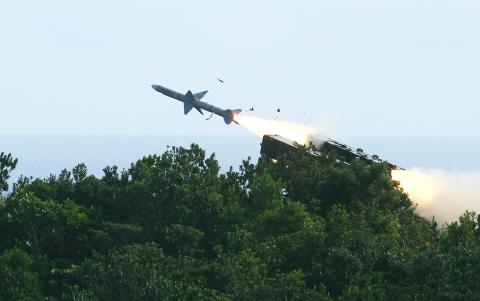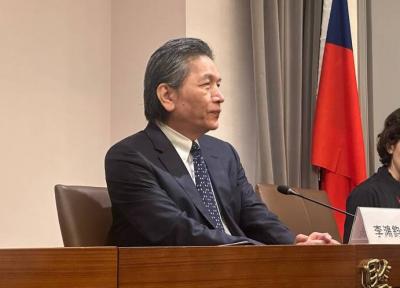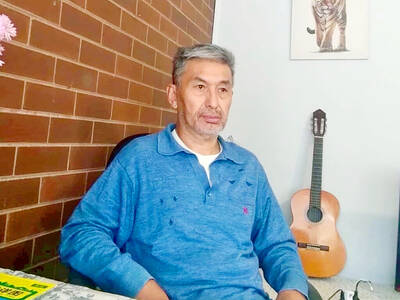Several hundred AIM/RIM-7 Sparrow air-to-air and surface-to-air missiles (SAM) used by the air force have been categorized as “for emergency use only” after three of the US-made missiles encountered technical failures during an exercise in January last year that left the military embarrassed.
Following the exercise, in which one RIM-7 climbed about 200m into the air before plummeting into the South China Sea, while another RIM-7 and one AIM-7 missed their targets, the military requested that US military personnel and Raytheon Corp, maker of the missile, investigate the reasons for the failures.
The Sparrow is a medium-range, all-weather and semi-active guided missile. Six hundred AIM-7Ms were part of a 1992 deal in which Taiwan procured 150 F-16A/Bs.

Photo: CNA
For its part, the RIM-7 SAM is used on towed launchers as part of the Skyguard Air Defense System. Five hundred entered service in 1991.
As Taiwan awaits a response, the air force has suspended the test-firing of Sparrow missiles, citing safety concerns.
The US has reportedly asked countries that have Sparrow missiles in their inventories not to fire them during exercises to diminish training risks. As a result, no Sparrows were fired during another major missile test in Jioupeng (九鵬), Pingtung County, on July 9, the same base used in last year’s exercise.
Citing sources in the military, local media said earlier this week that US military personnel had attributed the failure in last year’s exercise to problems with the missile’s rocket propeller and radar cross section, which plays an essential role in radar range calculation.
Until answers are received, Taiwan’s stockpile of Sparrow missiles will be kept in storage.
To address the impact of that decision on air defense capabilities, the military has reportedly decided to provide two additional battalions with Antelope Air Defense Systems, which are equipped with the a surface-to-air version of the domestically produced Tien Chien I missile.

Taipei has once again made it to the top 100 in Oxford Economics’ Global Cities Index 2025 report, moving up five places from last year to 60. The annual index, which was published last month, evaluated 1,000 of the most populated metropolises based on five indices — economics, human capital, quality of life, environment and governance. New York maintained its top spot this year, placing first in the economics index thanks to the strength of its vibrant financial industry and economic stability. Taipei ranked 263rd in economics, 44th in human capital, 15th in quality of life, 284th for environment and 75th in governance,

The Sports Administration yesterday demanded an apology from the national table tennis association for barring 17-year-old Yeh Yi-tian (葉伊恬) from competing in the upcoming World Table Tennis (WTT) United States Smash tournament in Las Vegas this July. The sports agency said in a statement that the Chinese Taipei Table Tennis Association (CTTTA) must explain to the public why it withdrew Yeh from the WTT tournament in Las Vegas. The sports agency said it contacted the association to express its disapproval of the decision-making process after receiving a complaint from Yeh’s coach, Chuang

Control Yuan Secretary-General Lee Chun-yi (李俊俋) tendered his resignation last night, admitting that he had misused a government vehicle, as reported by media. His resignation was immediately accepted by the Control Yuan. In a statement explaining why he had resigned, Lee apologized for using a Control Yuan vehicle to transport his dog to a pet grooming salon on May 20. The issue first came to light late last month, when TVBS News reported that Lee had instructed his driver to take the dog to the salon. The news channel broadcast photos that it said were taken by an unnamed whistle-blower, which purportedly showed the

A former officer in China’s People’s Liberation Army (PLA) who witnessed the aftermath of the 1989 Tiananmen Square massacre has warned that Taiwan could face a similar fate if China attempts to unify the country by force. Li Xiaoming (李曉明), who was deployed to Beijing as a junior officer during the crackdown, said Taiwanese people should study the massacre carefully, because it offers a glimpse of what Beijing is willing to do to suppress dissent. “What happened in Tiananmen Square could happen in Taiwan too,” Li told CNA in a May 22 interview, ahead of the massacre’s 36th anniversary. “If Taiwanese students or